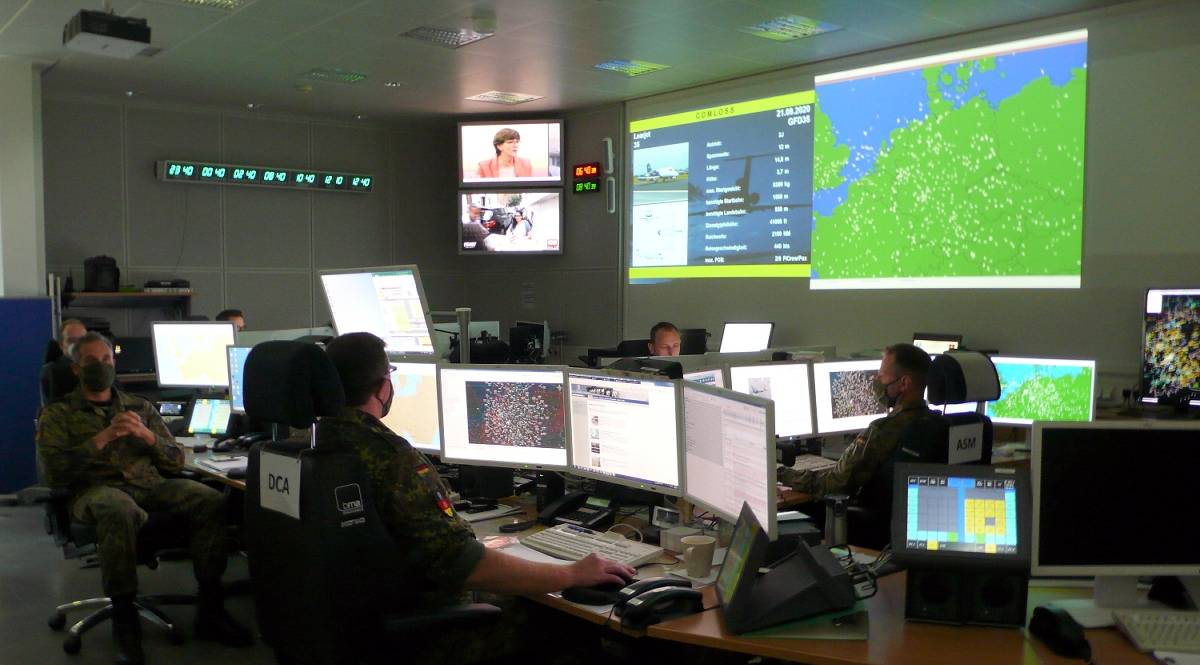Air Force Space Operations Centre The Bundeswehr gazes into space from the Lower Rhine
Uedem · On Monday, the new Air Force Space Operations Centre was put into service in the Lower Rhine region. In some cases the space radar in Wachtberg comes into play. A visit.
In the morning sun, the general's star shimmers golden on the epaulette of Burkhard Potorzky. But more shine comes from the silver wing on his chest. It is unusual by Bundeswehr standards, its shape is reminiscent of the uniform of the legendary TV hero Captain Kirk of the starship Enterprise. Indeed, the brigadier general is orienting himself towards space in Uedem. He is "General Space Operations“.
"GSSAC" is written on the silver emblem. Like almost everything here at the Nato site it is an English abbreviation. Its "German Space Situational Awareness Centre" is something like the German Space Surveillance Centre. That makes Potorzky the host for Defence Minister Annegret Kramp-Karrenbauer (CDU). She travelled to the Lower Rhine this Monday to "think together and organise together what belongs together" from now on, as she explains in front of flashing light dots on huge maps of Germany and Europe. She puts the "Asoc" into service. The Air and Space Operation Centre monitors everything that flies over Germany from Uedem. All the way up into space.
When Eurofighters take off on alert in Neuburg on the Danube or in Wittmund in East Frisia to prevent an attack with civilian aircraft as on 11 September 2001, they have received their orders from Uedem. As soon as civil air traffic control loses contact with an aircraft or a passenger jet shows other abnormalities, they inform the military. This morning things remain calm. There are currently 450 aircraft in the air over Germany. Each one is displayed on monitors. That is a small number. Usually at this time of day there are 3,000 jets flying at the same time. Corona sends its greetings. During the shutdown there were only 15 of them flying in or out.
Less and less space in the space above Germany
Compared to what was happening in the first ten kilometres over Germany, it was relatively quiet in the heights above a few years ago. Every now and then, a tank of a space rocket or a discarded satellite plunged back into the atmosphere. But there’s less and less space in the space above Germany.
Last year the world counted a good 1,800 satellites, now it is already 2,500, and the number is growing week by week. Some have also been destroyed for test purposes and have turned into thousands of pieces of space debris. They are now threatening a critical infrastructure that has become indispensable for life in Germany too.
Anyone who destroys satellites in the event of a conflict in Germany not only paralyses navigation and communication to a large extent. The financial markets will also collapse. Every remittance needs to be confirmed by a time signal from space. Aviation itself is also satellite-based. Kramp-Karrenbauer not only refers to space debris, but also to "targeted attacks". This is the threat of lasers or dangerous approaches.
The control centre also looks at imminent solar storms
The Asoc is currently tracking a crashed satellite. A week and a half ago it re-entered and crossed Germany several times, which is why the civil protection office also became aware of it. In Uedem, they now expect it to burn up over the Atlantic. It could also happen otherwise. If, for example, old Soviet large satellites with nuclear reactors on board re-enter. This could leave behind remnants of several metres in size.
They belong to the 19,372 objects in space that are recorded in Uedem. From next month on, the brand-new "GESTRA" radar system from the Schmidtenhöhe near Koblenz will make it even easier to follow how they move. "We will then also be able to identify smaller pieces of space debris," says Kramp-Karrenbauer with audible anticipation in his voice. If the operations centre in Uedem, or even a partner country is interested in a single special object, the military uses the TIRA radar in Wachtberg. It can even detect the direction of rotation of small satellites.
As complex as the situation in space becomes, there is at least one piece of good news coming out of Uedem at the moment. From here, the operations centre also looks at imminent solar storms.
Original text: Gregor Mayntz. Translation: Mareike Graepel




